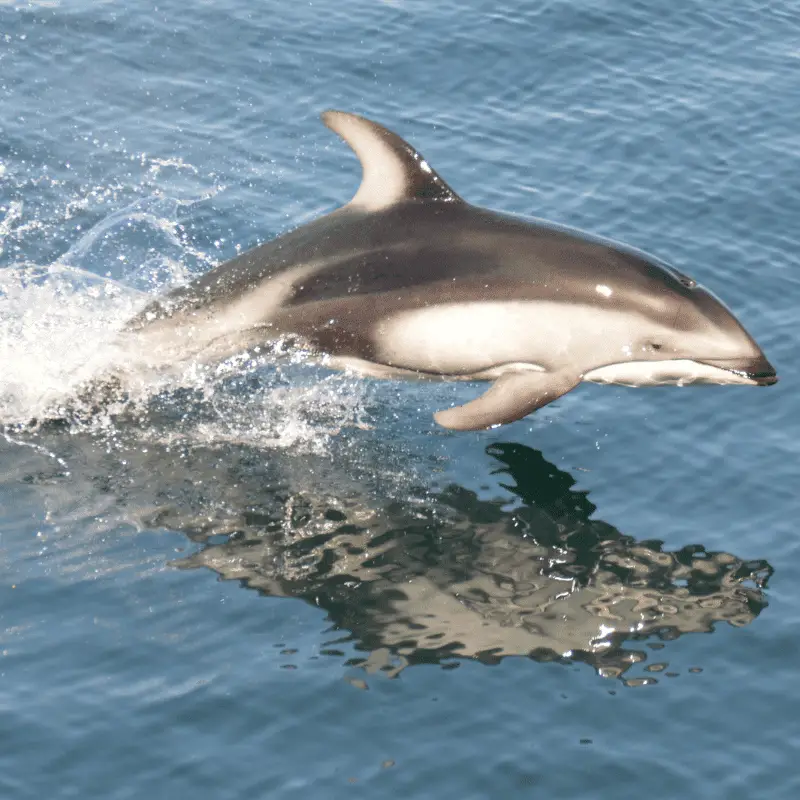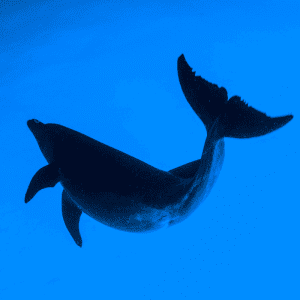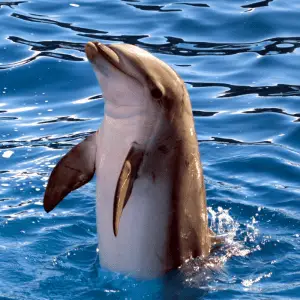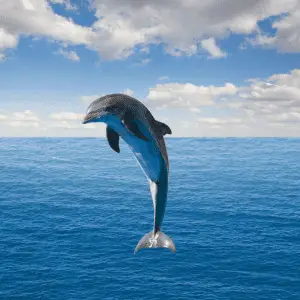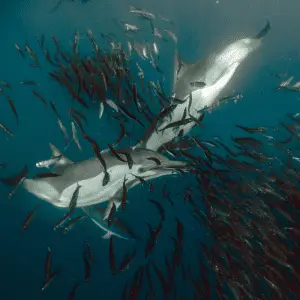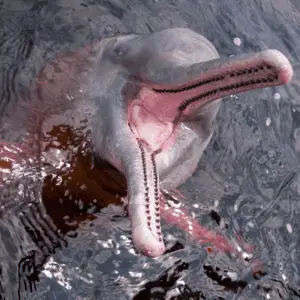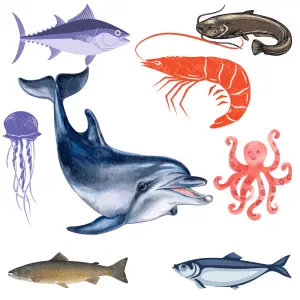Dolphins communicate mainly through sound, but they also use several nonverbal gestures to express their thoughts and feelings to other pod members or other species. The dolphins also make physical contact with other dolphins to communicate.
Dolphin Blowhole – Sounds
Besides breathing, the dolphins also use these blowholes to make various sounds. They can contract and manipulate the size of the blowhole by altering its shape.
This changed shape of the blowhole helps the dolphins create a specific sound that allows them to communicate with other dolphins in their pod and the dolphins of the other groups.
As sound travels 4 to 5 times faster in water than in air, dolphins can communicate with their peers located miles away.
They use various kinds of sounds to grab the attention of the other members of their group.
Sounds List Of a Dolphin
Dolphins make lots of different sounds. A dolphin can mix these many sounds in a short time.
- Chirping
- Clicking
- Creaking sounds
- Giggles
- Grunts
- Moans
- Raspberry sounds
- Screams
- Squeaks
- Whistling
Methods Of Communication
Dolphins communicate by making several sounds such as giggles, whistles, clicking and raspberry sounds. This way of communication with the dolphins is both fantastic and remarkable. It shows that dolphins are superiorly intelligent at initiating and maintaining social relationships.
Signature whistle
Every individual dolphin has a specific whistle that works as its identification. Dolphins create a signature whistle sound by controlling the frequency level of the whistle.
When a baby calf is born, they do not have a signature a whistle. But as they grow, they start to develop a signature whistle early in their life. When the dolphin babies are two years of age, they have learned and have their signature whistle style.
Can dolphins change their signature whistle?
Yes, dolphins can change their signature whistle over time if it benefits them in any way, such as if they form an alliance or friendship with another dolphin.
Whenever two pods of dolphins encounter each other, they immediately start whistling to engage in social behaviour. Some may need to change their whistle signature to improve socialisation and acceptance within the other group.
Do dolphins ever copy another dolphins signature whistle?
Even though each of the dolphins has its signature whistles, dolphins can copy the whistling sound of each other. The baby dolphin starts their signature whistling off by copying the whistling style of their mothers and adapting it to their own. Another reason why the dolphins copy others signature styles is because they may be calling each other. Copying the whistling also may be the way of acknowledging a pod member or a signal that they are nearby the dolphin with the particular whistle.
Echolocation
Echolocation plays a significant role in dolphin communication. Dolphins use sound waves to find out the location of other dolphins and other objects in the water. The dolphins produce burst pulses of broad-spectrum sound waves that sound like clicks to us.
When the sounds reflect the object, the sound waves return to the dolphin. The dolphins then use their factory lower jaw to receive this sound reflection.
Rapid transmission of this acoustic information from the lower jaw to the brain enables the dolphins to process the data and interpret it rapidly.
The eyesight of the dolphins is good; however, they still generally use location techniques to navigate their way through the water, especially when visibility is poor.
The echolocation technique of the dolphins is so good that they can differentiate between a golf ball and a ping-pong ball by analysing the object’s density.
This technique helps a dolphin find food anywhere in the water, no matter how murky it is, not only that they can find any prey hiding under the sand.
Recommended read: What Do Dolphins Eat?
Expression Through Body
Apart from a signature whistle and echolocation, dolphins also communicate with other pod members using their bodies.
The body expression method of communication does not use any vocal organs such as air sacs or the larynx. Instead, a dolphin will hit the water’s surface with its tail. Another way they use their body to express communication is called breaching. A dolphin will get their whole body out of the water and then crash on the water’s surface with a significant force.
Tail Slapping
Tail slapping on the water’s surface is a prominent sign of this dissatisfaction, warning, and also used in getting other dolphins’ attention.
Dissatisfaction
Dolphins can use tail slapping to show dissatisfaction towards another pod member or preditor trying their luck.
Warning Signal
Dolphins can use tail slapping to warn other dolphins away from an area.
Attention
Tail slapping sound is an attention-getting signal that can make all the other dolphins aware of the situation even if there is no vocalisation involved.
Breaching
The sound that breaching creates can tell other dolphins about their location. However, most of the time, dolphins showcase this kind of behaviour to dislodge any parasites located on its body. They also use this technique to hurt their prey or direct them towards a location.
Breaching can also be regarding the emotional or motivational status of the dolphin.
Visual Information Clues
Everything works as a visual cue for communication, from movements to colouration. Even though dolphins’ communication is mostly considered acoustic, several communications also happen within the visual way. For example, the Atlantic spotted dolphin develops spots as they become old. With these markings on their bodies, the aged dolphins can relay information about their age to other dolphins. Body markings can also help the dolphins differentiate between two species.
How do dolphins find their prey in dirty water?
Dolphins use the echolocation method to find prey when they cannot see. When a dolphin makes a sound, it gets back information about what is around them.
Person Recommendation
Dolphin communication is very complex, so complex that we still dont entirely understand it. If you want to learn more about the communication of a dolphin, Denise L. Herzing is the founder and Research Director of the Wild Dolphin Project, and her work is remarkable. I have been following her information on dolphin communication for many years. If you are as interested in dolphins as much as I am, you will find her studies fascinating.
- Denise L. Herzing on Twitter
- The Wild Dolphin Project

